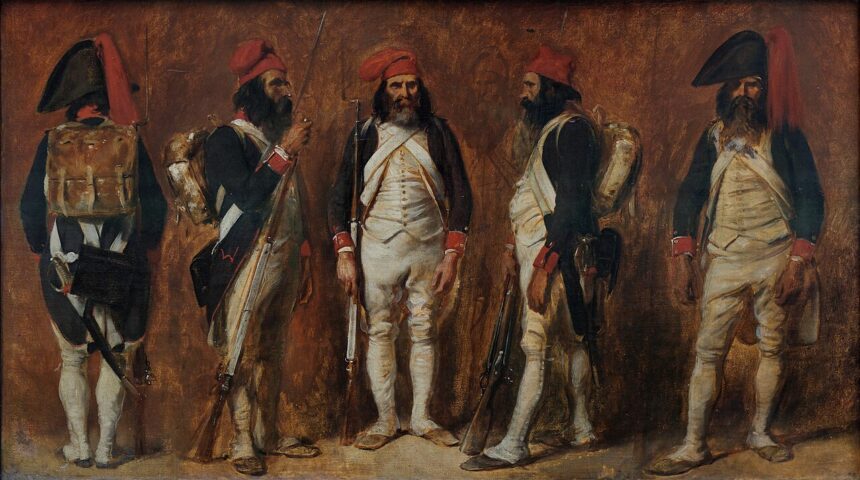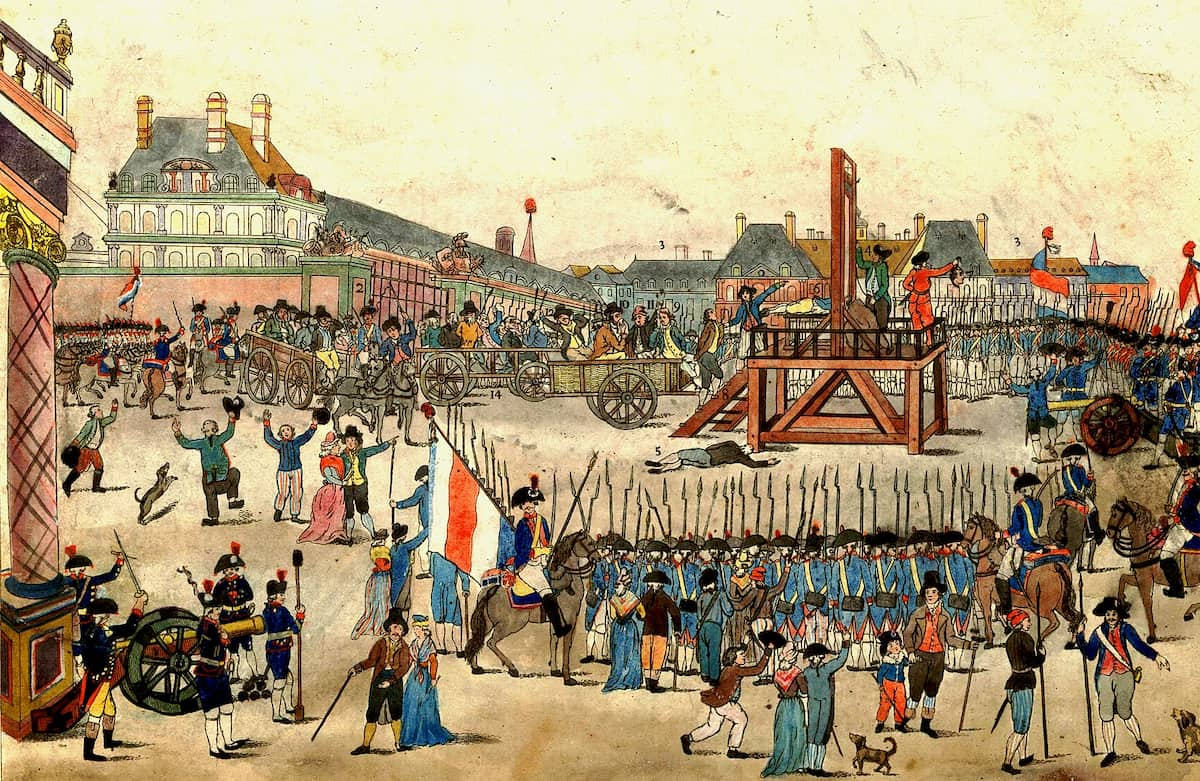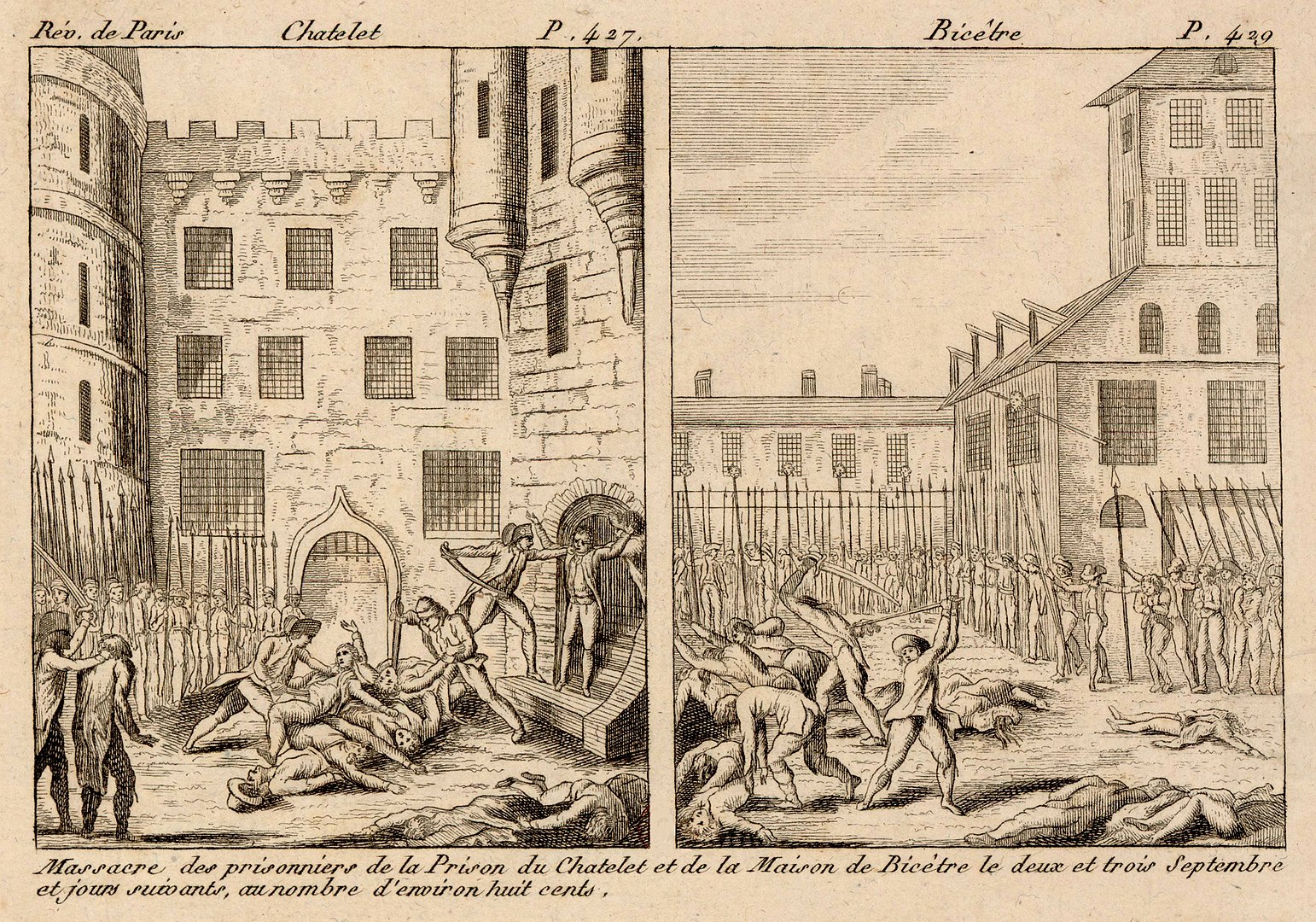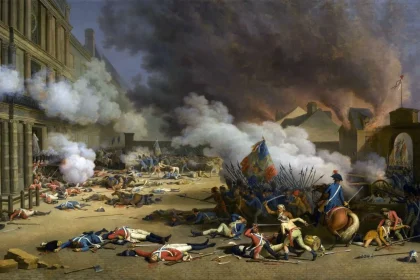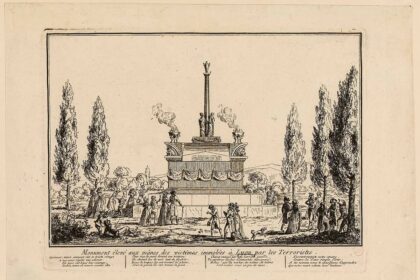Spanning from 1792 to 1804, the French First Republic was a regime established in France during the French Revolution, after the end of the monarchy. It ended with the establishment of the First Empire by Napoleon Bonaparte. It all began in 1792, when revolutionary France was in complete chaos. Surrounded by enemies, the constitutional monarchy declared war on Prussia and Austria but soon found itself threatened with invasion. On August 10, the National Assembly declared the removal of Louis XVI.
After the victory at Valmy, the new government abolished the monarchy and established the First Republic. Three political regimes would then succeed one another: the Convention, the Directory, and the Consulate. When the Reign of Terror was declared, France experienced its darkest hours. In 1795, a young army officer appeared and finally brought peace: Napoleon Bonaparte.
Why Was the French First Republic Established?
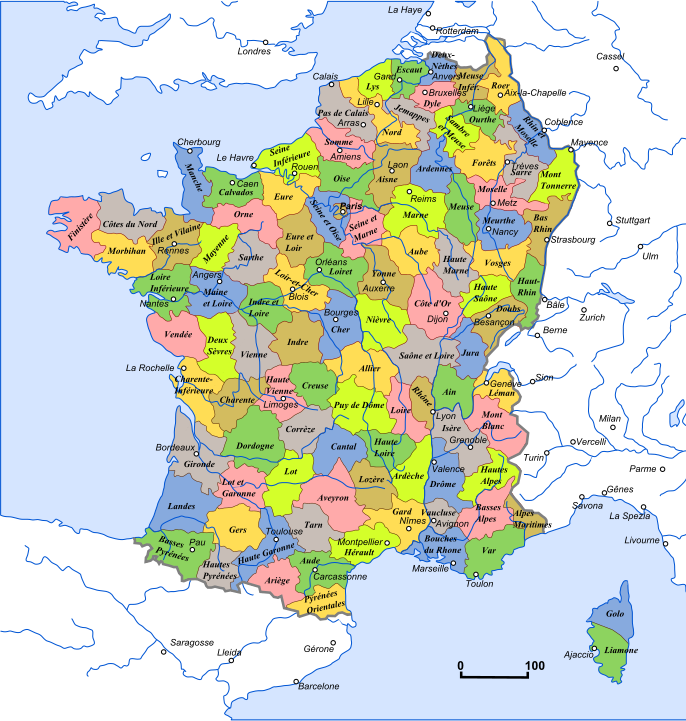
In 1792, the Holy Roman Empire and the Austrian Empire were at war with France. Suffering from significant internal turmoil, the young constitutional monarchy was seeking legitimacy and stability. During the famous Battle of Valmy, the revolutionary army faced the Prussian troops marching toward Paris. France won its first victory against the European monarchies. Emboldened, the Convention abolished the monarchy and, on September 22, 1792, proclaimed the French Republic!
Who Successively Governed During the First Republic?
Following the removal of Louis XVI in August 1792, France desperately needed strong leadership. On September 21, 1792, the National Convention was elected by universal male suffrage. It quickly abolished the monarchy and established the First Republic. On October 26, 1795, after violent internal strife, the Directory replaced it. The Directory governed France until Napoleon Bonaparte’s coup d’état on 18 Brumaire (November 9, 1799). The Consulate was established and lasted until the proclamation of the First Empire on May 18, 1804.
How Did the First Republic Come to an End?
At the beginning of 1804, a royalist conspiracy was uncovered, and its instigators were executed. Napoleon, then First Consul for life, was more powerful than ever. With significant support, he strengthened his control over the various legislative chambers. These bodies granted him the title of Emperor of the French on May 18, 1804, through a Senate decree (the “senatus-consulte”). This marked the end of the First Republic and the birth of the First Empire. France entered an era of grandeur!
When Did the Second Republic Take Place?
After the First Empire, France saw the Restoration from 1815 to 1830 and the July Monarchy from 1830 to 1848. During the latter, Louis-Philippe I was proclaimed King of the French. In the early 1840s, France was severely affected by an economic and social crisis. Significant price increases led to uprisings that drove the monarch from power. The French Second Republic was established on February 24, 1848, and was later abolished on December 2, 1852, when Louis-Napoleon Bonaparte also became Emperor of the French.
French First Republic: Key Dates
August 10, 1792 – Storming of the Tuileries
A decisive day of the French Revolution, August 10, 1792, marks the abolition of the French monarchy. In response to the threat of foreign invasion, insurgents attack the Tuileries Palace. They seize Louis XVI, who had been under house arrest since his flight to Varennes. Shortly after, the National Assembly deposes the king and strips him of his powers. These political upheavals will lead to the “September Massacres” and the beginning of the first Reign of Terror.
September 22, 1792 – Abolition of the Monarchy
At the end of August 1792, the armies of King Frederick William II of Prussia advance into eastern France. European courts aim to overthrow the Revolution and restore Louis XVI to the throne. The victory of General Dumouriez at Valmy provides the revolutionary government with the legitimacy it lacked. The next day, the National Convention definitively abolishes the monarchy in France!
February 23, 1793 – The Convention Orders the Conscription of 300,000 Men
From 1792, France is opposed to the First Coalition, an alliance of several European powers. To confront this, the Convention orders the enlistment of 300,000 men across the entire territory on February 23, 1793. Each French department provides its share of “volunteers,” single men or widowers, for the Republic’s army. This authoritarian mass conscription will lead to the War in the Vendée by March 1793.
March 10, 1793 – Creation of the Revolutionary Tribunal
After the peasant uprising in the Vendée, the National Convention establishes the Revolutionary Tribunal. This body is tasked with “judging conspirators and counter-revolutionaries without appeal or recourse.” The Tribunal becomes the main instrument of the Terror. A famous quote by Danton resonates: “Let us be terrible, so that the people do not have to be.”
October 10, 1793 – Saint-Just Declares the Convention
On August 10, 1793, the Convention, dominated by the Montagnards, suspends the constitution. For Saint-Just, the youngest member of the Assembly, the Republic could not survive otherwise. He declares a true revolutionary dictatorship to restore order, led by the Committee of Public Safety. The decree adopted on October 10, 1793, states: “The government will be revolutionary until peace is achieved.”
November 6, 1793 – Philippe Égalité Dies on the Scaffold
Before the Revolution, Louis-Philippe d’Orléans, a prince of royal blood, was opposed to Louis XVI’s regime. In 1792, he is elected to the National Convention under the name Philippe Égalité, as princely titles are banned. When his son, the future Louis-Philippe I, defects to the enemy in April 1793, Philippe is suspected of complicity and arrested. He is tried by the Revolutionary Tribunal and guillotined on November 6, 1793.
November 24, 1793 – The Revolutionary Calendar is Published
The work of poet François Fabre d’Églantine, the revolutionary calendar breaks from France’s Christian heritage. Established by the Convention on November 24, 1793, it completely reorganizes the lives of citizens. Weeks now have ten days, no longer dedicated to saints but to the land. Months are named after seasons and each lasts thirty days. Sunday rest and religious holidays disappear, replaced by patriotic festivals called “sans-culottides.”
February 3, 1794 – The Convention Abolishes Slavery
Slaves were the great forgotten ones in the 1789 Declaration of the Rights of Man and of the Citizen. Since they were denied liberty and equality, they began revolting in Guadeloupe and Saint-Domingue in 1793. Finally, on February 3, 1794, the National Convention votes to abolish slavery in French colonies. It declares that all men, regardless of color, are French citizens and enjoy the same rights.
May 7, 1794 – The Cult of the Supreme Being
In 1794, Maximilien Robespierre dominates the Committee of Public Safety and the revolutionary assembly. Seeking to end the old regime, he supports the dechristianization of France. However, he knows that the people need religious symbols. On May 7, 1794, the Convention institutes the Cult of the Supreme Being, a nameless, faceless deity. Its festival coincides with Pentecost from the previous calendar.
June 10, 1794 – The Convention Decrees the Terror
On September 5, 1793, as France is besieged on all sides, the revolutionary government institutes the Terror. However, repression and the fear of the guillotine are not enough. On June 10, 1794, pushed by Robespierre, the Convention decrees the Great Terror! Trials are rushed, and the judicial protections of the accused are abolished. Nearly 40,000 people are arbitrarily executed during this period.
July 27, 1794 – End of the Terror
As France seems now secure, many deputies wish to end the Terror. They especially aim to enjoy the power and wealth they acquired during the Revolution. On July 27, 1794, Robespierre, then president of the Committee of Public Safety, and his supporters are arrested. They are guillotined the next day without trial. This marks the end of the Terror!
February 21, 1795 – Restoration of Freedom of Worship in France
After the Terror, the government seeks to reconcile the French with the Revolution. On February 21, 1795, the Convention restores freedom of worship, limited since the Civil Constitution of the Clergy in July 1790. The state thus authorizes the practice of religion, but it must be done without ostentatious signs. Moreover, the state is no longer responsible for managing places of worship.
July 14, 1795 – The Marseillaise Becomes the National Anthem
Written in 1792 during the wars against Austria, the Marseillaise was originally a revolutionary war song. An ode to liberty, it is also a patriotic call for general mobilization and the fight against foreign powers. On July 14, 1795, the Marseillaise becomes the national anthem of France, promoted by the Convention. In 1804, under the First Empire, it is replaced by the Chant du Départ.
October 5, 1795 – Bonaparte’s First Intervention
After Robespierre’s execution, the royalists eventually rebel. In Paris, clashes erupt between the army and rioters planning to attack the Tuileries Palace, the seat of government. On October 5, 1795, the young Republican officer Napoleon Bonaparte is summoned and tasked with quelling the insurrection. He succeeds by bringing in cannons to fire on the angry crowd.
October 26, 1795 – Beginning of the Directory
After three years, the National Convention gives way to the Directory on October 26, 1795. With this new regime, the government seeks to move past the Terror and the Revolution. Elections are held to choose the members of the two legislative chambers: the Council of Elders and the Council of Five Hundred. Thus begin four years during which the Directory works to reform France.
January 2, 1796 – Creation of the Ministry of Police
When the Revolution broke out, the royal police, which had failed to anticipate it, was overwhelmed and disappeared along with the monarchy. On January 2, 1796, the Directory creates the Ministry of General Police. To combat persistent insurgent unrest across France, the government seeks a strong law enforcement force. Unfortunately, crime does not decrease, and conspiracies continue…
September 10, 1796 – The Directory Crushes the “Babouvists”
In 1796, French revolutionary Gracchus Babeuf instigates the “Conspiracy of Equals.” This attempted overthrow arises in a very difficult social context. The goal of “Babouvism” is to achieve the collectivization of land and production means. After a failed military uprising in Grenelle, the Conspiracy is exposed and arrested. Gracchus Babeuf is guillotined on September 10, 1796.
September 4, 1797 – Fructidor Coup
In 1797, new elections are held to renew a third of the two assemblies of the Directory. Citizens vote massively for moderate deputies, favorable to restoring the monarchy. On September 4, 1797, some Directory supporters, backed by Bonaparte, stage the Fructidor coup against the royalist parliamentarians. Many of them are arrested and deported, while the elections are annulled.
May 11, 1798 – The Coup of 22 Floréal Year VI
In April 1798, elections are held again within the Directory. The votes are highly favorable to the Jacobins, a political faction in decline since the fall of Robespierre. Although they hold the majority for a few more days, the current Directors decide to prevent their return. On May 11, 1798, in what amounts to a coup d’état, they pass a law that voids the elections.
November 9, 1799 – Coup of 18 Brumaire
At war and threatened by a royalist resurgence, the Revolution is on its last legs. On November 9, 1799, during the coup of 18 Brumaire, Napoleon Bonaparte ends the Directory. Through clever manipulation, he is appointed First Consul of the Republic and then head of the executive. Although France remains a republic for a few years, Napoleon Bonaparte becomes the sole leader. The Revolution is over.
December 13, 1799 – Birth of the Consulate
Following their coup, Bonaparte, Sieyès, and Ducos establish the Consulate with the constitution of Year VIII, on December 13, 1799. This new political regime is led by three consuls and significantly strengthens the power of the executive. The rights of man and citizen, as well as the defense of liberties, are absent from the text. As First Consul, Bonaparte is more powerful than ever and restores peace in the Republic.
January 18, 1800 – Creation of the Bank of France
Having made a fortune during the Revolution, Swiss financier Jean-Frédéric Perregaux opens the “Caisse des Comptes Courants” in Paris. A few years later, he proposes to Napoleon Bonaparte that his institution be granted the right to print banknotes. This would allow him to collect French savings and increase the amount of money in circulation. Bonaparte agrees and establishes the Bank of France on January 18, 1800.
May 19, 1802 – Creation of the Legion of Honor
To reward civil and military merits, Napoleon Bonaparte creates the National Order of the Legion of Honor on May 19, 1802. This distinction is intended to recognize those who have rendered “eminent services” to the Nation. It initially includes four classes, later expanding to five: Knight, Officer, Commander, Grand Officer, and Grand Cross. This act further enhances the prestige of the First Consul.
August 2, 1802 – Napoleon Becomes Consul for Life
In 1802, Napoleon Bonaparte has significantly strengthened his power over France. For bringing stability to the Republic, the Tribunate, one of the legislative chambers of the Consulate, seeks to grant him national recognition. The people are consulted, and an overwhelming majority votes in favor of this reward. Thus, on August 2, 1802, following political maneuvers, Bonaparte becomes Consul for life.
March 28, 1803 – Creation of the Germinal Franc
During the Ancien Régime, the currency unit was the livre tournois, which was replaced by the franc during the Revolution. On March 28, 1803, Napoleon Bonaparte creates the “germinal franc” and gives it a fixed value and weight. This decision aims to balance the nation’s commercial transactions. Strong and stable, the germinal franc becomes the reference currency in Europe during the Napoleonic wars.
March 21, 1804 – Publication of the Civil Code
Under the monarchy, each French territory had its own laws and local customs. On March 21, 1804, Napoleon Bonaparte promulgates the “Civil Code of the French.” From then on, the law is created by legislators, applied by judges, and governs social relations among all French citizens. The Civil Code is one of Bonaparte’s greatest contributions and has inspired many other countries since.
March 21, 1804 – Assassination of the Duke of Enghien
In early 1804, a royalist plot orchestrated by Georges Cadoudal is uncovered. The investigation, led by Fouché, results in the execution of Cadoudal. The Duke of Enghien, a French prince, is suspected—without solid evidence—of being part of the conspirators. He is kidnapped in the Grand Duchy of Baden, where he had taken refuge, quickly judged, and executed by firing squad in the moat of the Château de Vincennes at night.
May 18, 1804 – Coronation of Napoleon
After the death of the Duke of Enghien and other participants in the royalist plot, Napoleon Bonaparte emerges politically stronger. On May 18, 1804, the Senate approves the Tribunate’s decision to grant Napoleon Bonaparte the title of Emperor of the French. The First Consul thus legally obtains the imperial dignity and its hereditary nature through a symbolic text: senatus-consulte.
December 2, 1804 – Bonaparte Becomes Emperor of the French
On December 2, 1804, Napoleon I is crowned Emperor of the French at Notre-Dame Cathedral in Paris. Pope Pius VII blesses the new imperial emblems: the ring, the sword, and the mantle, and anoints both Josephine and Napoleon. Napoleon then places the crown on his own head. Many French citizens approve of this coronation, seeing it as a way to forever repel the specter of royalty.


